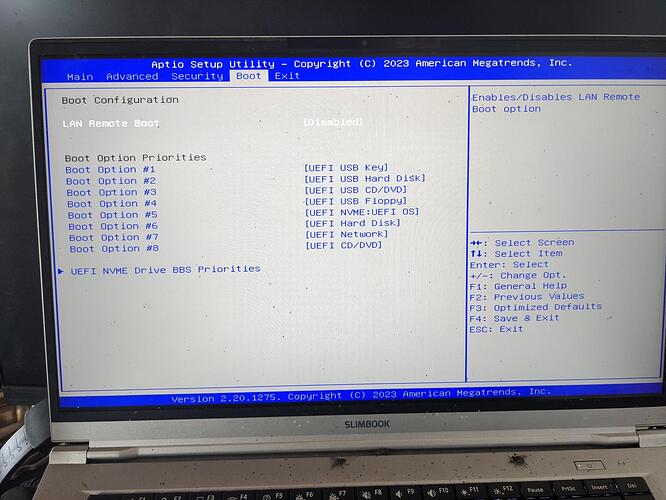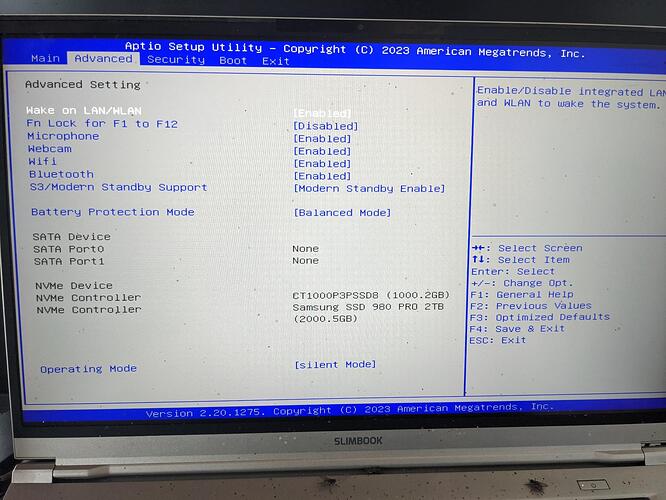These are all the BIOS options @brahma
you have also a fly problem haha ![]()
![]()
in the bios under advanced options, what is the operating mode option?
ok, test with windows, if it has also issues it probably is a hardware problem…
@brahma I’ve installed windows 10 and after updating the system to download graphic drivers I’ve got this error windows unexpected kernel mode trap So looks like something is failing on the hardware ![]()
it really looks like a hardware problem…
were you overclocking your cpu/gpu?
check this link and follow the steps number: 1,3,5,6…
I think I didn’t overclock it… Regarding to operating mode options are: silent mode and performance mode
so if you didnt overclock it, its probably a hardware issue… maybe the overheating that you mentioned damaged something…
I believe so, but that happened at mid July and it failed after the system update bug I faced. So that’s why I’m a bit confused about this stuff ![]() Do you think is better to purchase another computer in the meanwhile or try to repair this one?
Do you think is better to purchase another computer in the meanwhile or try to repair this one?
Depends what is broken, perhaps just replace the broken parts cheaper.
maybe purchase another AMD replacement?
you could get it serviced for some diagnostics, tell them that the gpu is probably broken, and what the options are, before buying a new pc…
that would be the best if you could just replace the amd, but since its a notebook, it will probably be integrated into the motherboard…
Hi,
Just an additional test you can do :
Fully disconnect your battery for a few minutes to see if this resets some hardware chips that would be stuck in a wrong status
To elaborate a bit further on this,
I have an old Thomson Tablet PC from 2015-2016 more or less, basically a cheap copy of the Asus T100.
The tablet came in with a dual boot Windows 8 / Android 4.
The Windows 8 part was upgraded to Windows 10 and I used it for some years before it became impossible to run it with 2gb of RAM only and 17Gb of reserved hard disk space.
I then dedcided to move to Manjaro XFCE.
Before that, I made a Clonezilla copy of the Win10/Android disk.
I installed Manjaro 64bit with a 32bit UEFI grub, configured everything, corrected the autorotation initiallly not working, install all the apps I like… as all of this is quite time-consuming, I decided to made another Clonezilla copy of this fully functional system to have some sort of backup easy to go to in case of problem…
Then, for fun, I decided to check if my Clonezilla copy of Win10/Android was working. So i restored it and everything was ok.
After that, quite happy, I restored the Clonezilla copy of the fully configured and functional Manjaro but…
I had no more sound, blutooth, touchscreen, rotation…
Even when starting a live Manjaro XFCE session from a USB key, I had the same issue !
However, the touchscreen was functional in the Bios… so it was not a hardware problem but somehow, the hardware was hiding the presence of some components to the operating system on boot.
For this reason, I decided to open the beast in order to reset all bios power/parameters.
I did not find any CMOS battery as the tablet is using directly the main battery to keep the bios parameters, date and time… alive.
So I disconnected the main battery for a while, reconnected it and restarted under a live Manjaro session.
Now, the touchscreen was back !
After rebuilding the kernels and inputting the proper bios settings, my Manjaro Clonezilla copy was fully functional again (writing this post from within now).
So, it may be worth a try before you discard it or bring it to a repair shop…
Hope it helps,
Multiple Edits : typo/spelling corrections…
Hello everybody, I’ve just purchased a second hand laptop, slimbook pro14, same as the one I have but smaller.
I’ve just moved my old NVMe and the 2 32GBM RAM to the new laptop and I’ve booted a live USB to fix some EFI issue trying to load windows instead of manjaro (I believe something I made wrong when I tested adding the other NVMe and installing there windows as suggested by @brahma )
Anyways, I"ve reinstalled EFI as I’ve followed this guide.
Once OS has started I’ve executed this to check the GPU and I’ve got this log:
sudo journalctl -b0 -p4 | grep 'amdgpu'
[sudo] password for urko:
nov 27 22:33:10 urko kernel: amdgpu 0000:04:00.0: amdgpu: psp gfx command LOAD_TA(0x1) failed and response status is (0x7)
nov 27 22:33:10 urko kernel: amdgpu 0000:04:00.0: amdgpu: psp gfx command INVOKE_CMD(0x3) failed and response status is (0x4)
nov 27 22:33:10 urko kernel: amdgpu 0000:04:00.0: amdgpu: Secure display: Generic Failure.
nov 27 22:33:10 urko kernel: amdgpu 0000:04:00.0: amdgpu: SECUREDISPLAY: query securedisplay TA failed. ret 0x0
there is this old patch ,
https://lists.freedesktop.org/archives/amd-gfx/2023-May/093287.html
may be others versions psp 10.0 need these point
those secure display logs are related to a new feature implemented by amd… here is more info on what it is:
you should ignore them… it may be fixed in some future update…
Hello again everybody. Since some testing with old laptop I’ve got it recovered. I’ll explain the steps I’ve done.
1- I purchased second hand slimbook proX14 AMD which was equipped with 2x8GB RAM + 500GB NVMe
2- I swapped my 2x32GB RAM + 2TB NVMe from proX15 to proX14.
3- I already noticed overheat and fan running to maximum speed.
4- I worked couple weeks like this as no error found yet but fan speed was making me think about some issue was on the NVMe somehow.
5- I backed up everything to external 2TB hard drive.
6- I mounted 2x8GB + 500NVMe that were initially on the second hand proX14 purchased to my proX15
7- I launched live USB with manjaro-kde-24.1.1-241011-linux610.iso
8- I replaced already Ubuntu OS on the 500NVMe with this Manjaro
9- Everything worked fine, the proX15 was running super good.
10- I added to proX15 the other 1TB NVMe I did purchase as suggested by @brahma when he pointed me out to install windows while those nomodeset tests
11- I used this 1TB NVMe as data partition and I copied all the backed up data from proX14 which was the laptop I was working on while my proX15 was stand by.
12- I’ve been working with proX15 for 10 days without any issues, I installed all packages and software I usually use and configured all the stuff like VPNs and so on
13- Yesterday I decided to swap the RAM
14- I changed proX15 2x8GB to 2x32GB
15- I switched on the laptop and after couple minutes using it then it crashed and rebooted.
16- Laptop was rebooting after trying to load OS so was stuck at the OS menu selection (don’t know very well the word to define this)
17- I switched it off and decided to remove just 1 32GB RAM from 1 slot, leaving the other alone.
18- I repeated same test as step 15 and same result as 16.
19- I decided to do the same with the other RAM slot but with the other 32GB RAM not the same I tested on step 17
20- Now it works.
I don’t know where is the issue as the 2x32GB RAM were working on proX14
I’m going to give proX14 to my brother with the 32GB RAM that make my proX15 crash and another 8GB RAM.
I don’t know anything of electronics yet, I would like to invest some time to do so but can’t do it right now ![]()
I would be grateful to read your comments regarding to this topic. By the way I’m going to test later adding the other 8GB RAM to the other free slot that is on my proX15
Hello again. I’ve tested this morning with the other free RAM slot placing the 8GB RAM to it.
I’ve switched the laptop on and after couple minutes without doing anything it rebooted causing same issue as the other failed tries.
So my believe is that RAM slot is broken somehow. At least it is not GPU ![]()
have you try memtest+uefi ?




